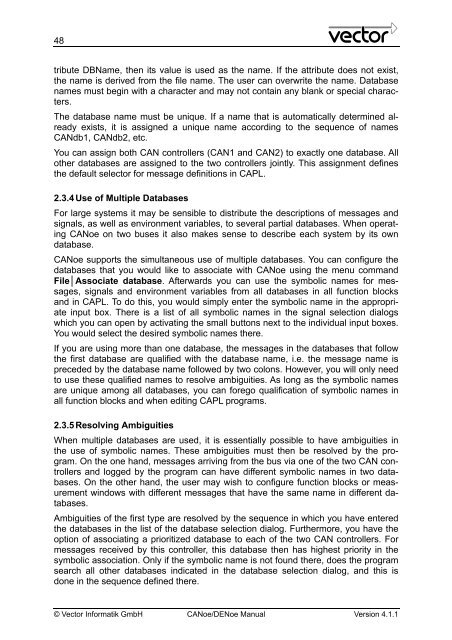CANoe DENoe - KEMT FEI TUKE
CANoe DENoe - KEMT FEI TUKE
CANoe DENoe - KEMT FEI TUKE
You also want an ePaper? Increase the reach of your titles
YUMPU automatically turns print PDFs into web optimized ePapers that Google loves.
48<br />
tribute DBName, then its value is used as the name. If the attribute does not exist,<br />
the name is derived from the file name. The user can overwrite the name. Database<br />
names must begin with a character and may not contain any blank or special characters.<br />
The database name must be unique. If a name that is automatically determined already<br />
exists, it is assigned a unique name according to the sequence of names<br />
CANdb1, CANdb2, etc.<br />
You can assign both CAN controllers (CAN1 and CAN2) to exactly one database. All<br />
other databases are assigned to the two controllers jointly. This assignment defines<br />
the default selector for message definitions in CAPL.<br />
2.3.4 Use of Multiple Databases<br />
For large systems it may be sensible to distribute the descriptions of messages and<br />
signals, as well as environment variables, to several partial databases. When operating<br />
<strong>CANoe</strong> on two buses it also makes sense to describe each system by its own<br />
database.<br />
<strong>CANoe</strong> supports the simultaneous use of multiple databases. You can configure the<br />
databases that you would like to associate with <strong>CANoe</strong> using the menu command<br />
File│Associate database. Afterwards you can use the symbolic names for messages,<br />
signals and environment variables from all databases in all function blocks<br />
and in CAPL. To do this, you would simply enter the symbolic name in the appropriate<br />
input box. There is a list of all symbolic names in the signal selection dialogs<br />
which you can open by activating the small buttons next to the individual input boxes.<br />
You would select the desired symbolic names there.<br />
If you are using more than one database, the messages in the databases that follow<br />
the first database are qualified with the database name, i.e. the message name is<br />
preceded by the database name followed by two colons. However, you will only need<br />
to use these qualified names to resolve ambiguities. As long as the symbolic names<br />
are unique among all databases, you can forego qualification of symbolic names in<br />
all function blocks and when editing CAPL programs.<br />
2.3.5 Resolving Ambiguities<br />
When multiple databases are used, it is essentially possible to have ambiguities in<br />
the use of symbolic names. These ambiguities must then be resolved by the program.<br />
On the one hand, messages arriving from the bus via one of the two CAN controllers<br />
and logged by the program can have different symbolic names in two databases.<br />
On the other hand, the user may wish to configure function blocks or measurement<br />
windows with different messages that have the same name in different databases.<br />
Ambiguities of the first type are resolved by the sequence in which you have entered<br />
the databases in the list of the database selection dialog. Furthermore, you have the<br />
option of associating a prioritized database to each of the two CAN controllers. For<br />
messages received by this controller, this database then has highest priority in the<br />
symbolic association. Only if the symbolic name is not found there, does the program<br />
search all other databases indicated in the database selection dialog, and this is<br />
done in the sequence defined there.<br />
© Vector Informatik GmbH <strong>CANoe</strong>/<strong>DENoe</strong> Manual Version 4.1.1








